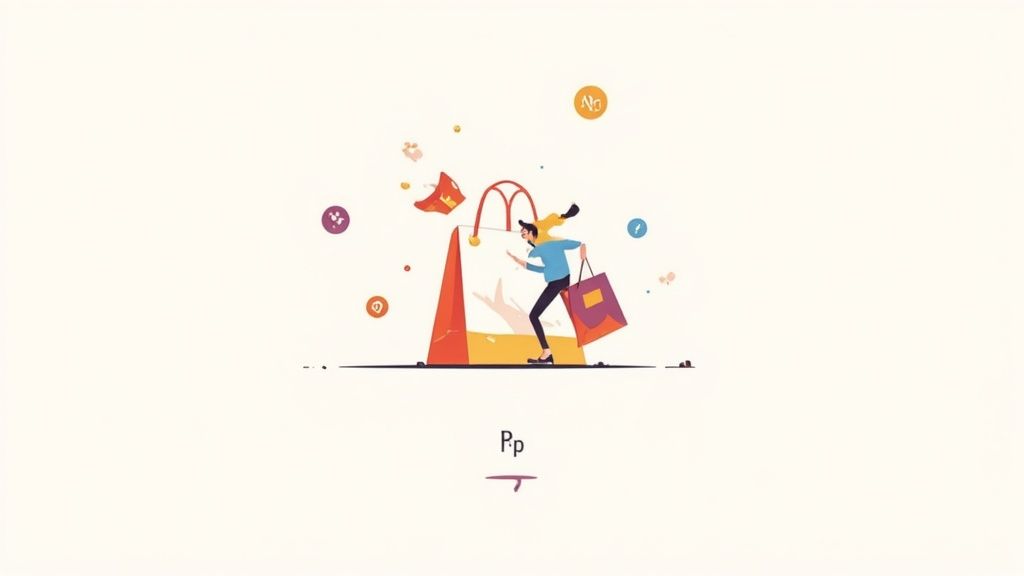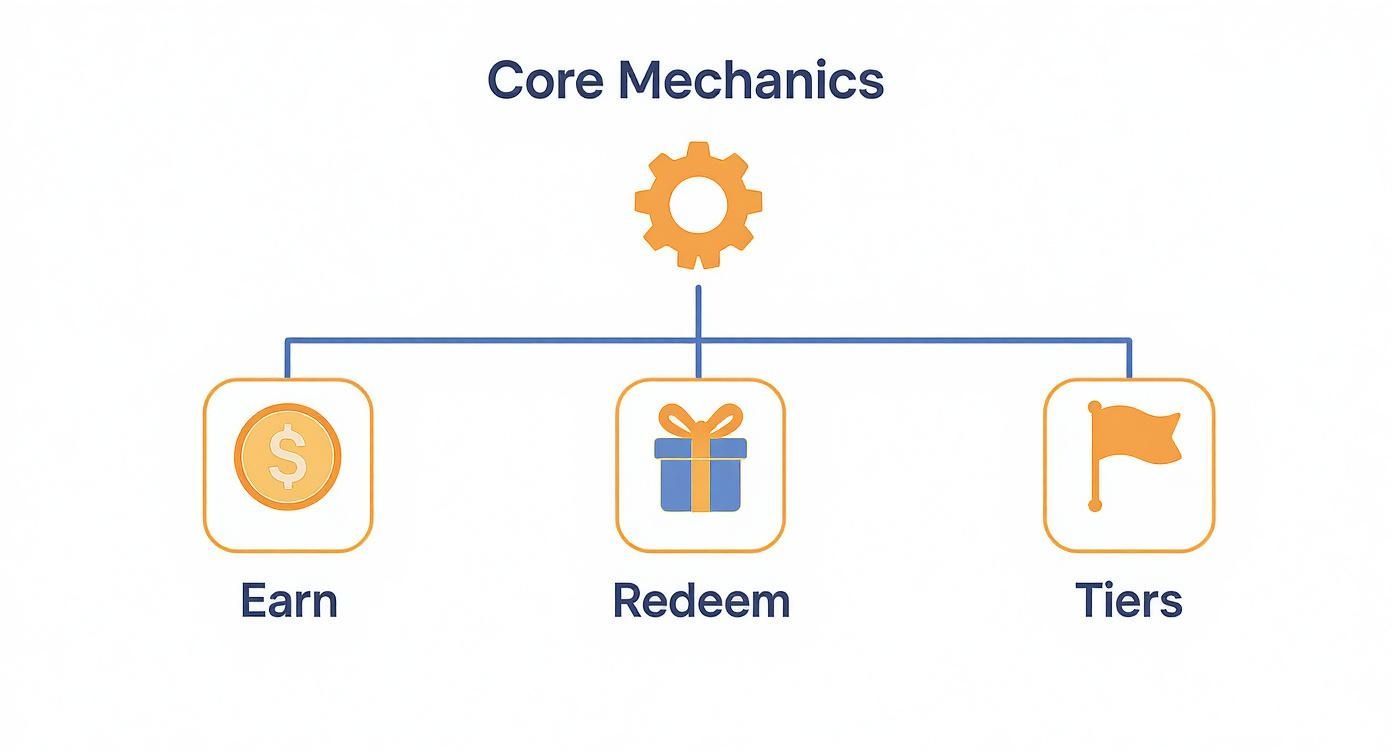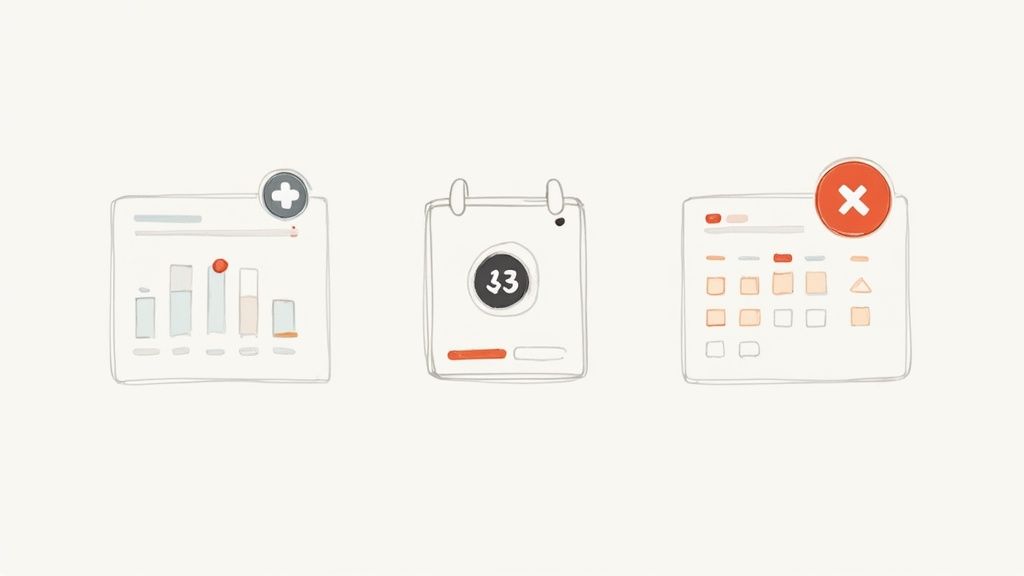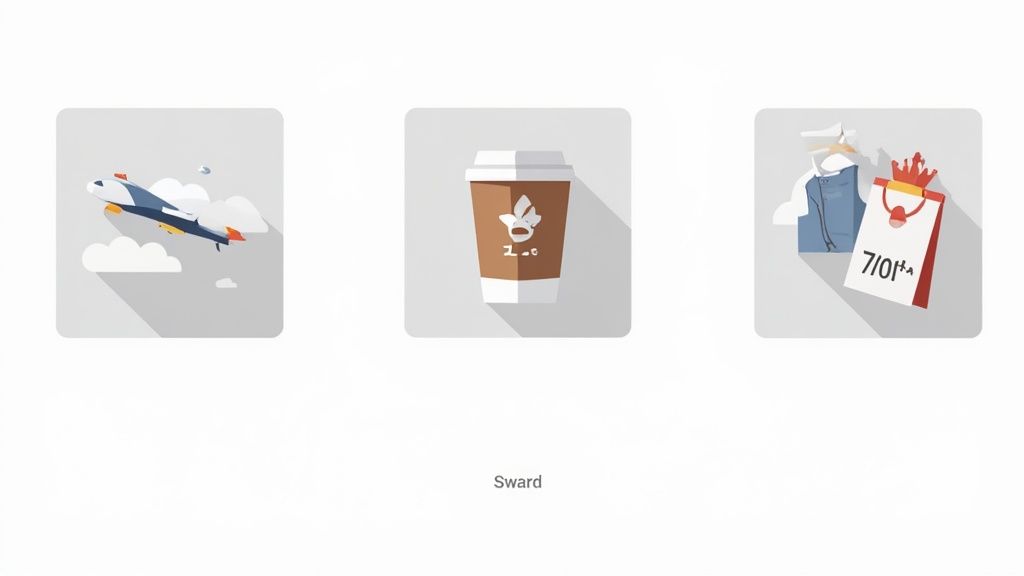Point Reward System Boosts Loyalty And Sales
Every purchase can feel like leveling up when you introduce a Point Reward System to your store. You hand out digital points for actions like buying a product or referring a friend, then let customers trade those points in for discounts or VIP perks. Small, steady wins mirror the gameplay experience everyone loves and keep shoppers coming back for more.
Understanding Point Reward System

A Point Reward System turns everyday shopping into a simple game of progress and reward. Customers collect points when they make purchases, leave reviews or share your brand on social media.
These points then become a kind of in-store currency. Shoppers can redeem them for future discounts, free items or early access to new products.
Why Merchants Should Care
For merchants, a point reward system is more than just a marketing gimmick—it’s a proven way to boost retention and drive repeat sales. In practice, shoppers return more often and spend more per visit, which directly lifts customer lifetime value (LTV).
Think of loyalty points as experience (XP) in a game:
- Earn points for purchases, reviews and referrals
- Redeem points for discounts, free products and exclusive access
- Climb tier levels to unlock bonus perks
- Set expiration rules to create urgency
Small rewards build positive momentum, while tiered milestones spark bigger shopping goals.
Roadmap For This Guide
In the sections ahead, we’ll cover:
- Earning & Redemption Mechanics: How points add up and are spent
- Tier Structures & Expirations: Keeping top customers engaged
- Gamification Tactics: Injecting fun into every interaction
- Technical Setup: Step-by-step tips for Shopify and omnichannel stores
- Key Metrics: Tracking enrollment, redemption rates and LTV
Real-world examples will highlight strategies that truly move the needle on retention and revenue.
“Every purchase is a step toward an exciting reward—just like gaining XP in your favorite game.”
By the end, you’ll understand why dedicating time to a point reward system pays off handsomely.
Comparing Points And XP
Points in a loyalty program function much like XP in video games—each point nudges shoppers closer to a milestone.
This familiar analogy makes loyalty programs instantly motivating:
- In games, XP unlocks new levels; in stores, points unlock rewards
- Gamers chase the next level; shoppers chase the next discount
- Visible progress bars spur action in both worlds
- Milestone badges and tier labels create status and pride
Later on, we’ll dive into setting point-earning rates, defining redemption values and managing tier expirations with precision.
Turning Shoppers Into Fans
A well-designed point reward system does more than encourage repeat buys—it builds genuine fans. Small victories create habit loops and strengthen emotional ties to your brand.
In the following guide, you’ll also discover how Toki simplifies setup and customization so you can launch a point reward program in minutes.
Ready to level up your customer loyalty and engagement? Let’s build a program that celebrates every sale like a win.
Core Mechanics Of A Point Reward System
Every loyalty program stands on two pillars: clear earning rules and transparent redemption options. Nail these, and you’ve set the compass for your customers’ journey.
Ahead, we’ll unpack the four gears—earning, burning, tiering and expirations—so you can design a system that feels generous yet sustainable.
Comparison Of Earning And Redemption Structures
A quick glance at common rewards setups will help you pick the model that fits your brand voice and business goals.
| Aspect | Earning Rules | Redemption Options | Tier Impact | Expiration Policy |
|---|---|---|---|---|
| Coffee Shop Model | 1 point per $1 spent | Free drink after 10 points | N/A | Points expire after 12 months |
| Tiered Retail | 2 points per $1 | $5 off per 100 points | Silver, Gold, Platinum perks | Fresh points valid for 6 months |
| Gamified Platform | Bonus points for actions | Exclusive items or experiences | Unlock badges and early access | Progressive expiration based on tier |
This table highlights how earning rates, reward value and program rules shift across industries.
Earning Rules Explained
Earning rules dictate how customers rack up points: they might shop, post reviews or share on social media. You choose the ratio—say, 1 point for every $1 spent—so that rewards feel meaningful without eating into profit.
A couple of ideas to spark engagement:
- Purchases earn base points based on spend.
- Writing reviews grants 10 points for each submission.
- Social shares unlock referral bonuses.
Redemption Options
Redemption is where points turn into perks. By laying out a range—from small discounts to free products—you guide shoppers toward higher-value choices. Learn more in our article on Store Credit Vs Points.
“A clear redemption path turns points into action.”
Tier Levels In Loyalty
Think of tiers like levels in a video game. As customers hit new milestones, they unlock perks—free shipping, bonus multipliers or early access—to keep them climbing.
A simple tier map could look like this:
- Bronze unlocks basic discounts and entry-level perks.
- Silver adds free shipping and birthday bonuses.
- Gold provides early access and higher bonus rates.
Tip: Balance thresholds so they feel within reach but still aspirational.
Expiration Rules
Putting an expiry on points injects a friendly dose of urgency. A 12-month window or a rolling expiration tied to the last activity date keeps things fair and fresh.
To keep customers informed:
- Send reminder emails 30 days before expiration.
- Offer extension bonuses to re-engage dormant customers.
- Allow point gifting or donation before expiry.
By combining transparent earning steps, flexible redemption options, motivating tiers and clear expirations, you’ve built a roadmap that drives repeat visits and boosts lifetime value.
Next Steps With Toki
Ready to bring this framework to life? If you sell on Shopify or operate across multiple channels, Toki makes setup a breeze with flexible rules and out-of-the-box tier management.
- Define point values based on your product margins.
- Configure earning rules in the Toki admin to match your strategy.
- Build a varied redemption catalog within the Toki dashboard.
- Activate tier levels and set your expiration policies.
- Monitor performance and refine your mechanics over time.
Business Benefits Of Point Reward System
A point reward system does more than thank customers—it turns occasional shoppers into repeat buyers while delivering clear, trackable ROI. By tagging purchases, reviews, or referrals with point values, you set up an engaging loop that nudges people toward the next action. Below, we explore how these data-driven rewards boost customer lifetime value and spark organic advocacy.
Direct Revenue Increases
Retailers often see a 8-12% jump in sales directly tied to loyalty initiatives. When customers know they’re earning points, they’re more inclined to add extra items or upgrade to higher-value bundles.
- Limited-Time Point Discounts drive quick bursts of demand
- Bulk Purchases become more attractive when tied to extra points
- Upsell campaigns peppered with point incentives lift average order size
Quantifying Customer Lifetime Value
Members who actively spend their points deliver up to 6.3× more lifetime value than non-members. And when you pair those points with personalized offers, annual spend can climb by 4.5×.
- Repeat Purchase Rate – Up to 20% lift after three months
- Average Order Value – 15% boost from point redemptions
- Retention Rate – 10-15% higher in tiered programs
“Loyal customers spend more, return more often and tell their friends.”
These figures show that a robust point program pays off both immediately and over the long haul.
Infographic Of Core Mechanics
The following diagram visualizes the core structure of a point reward system, detailing how earning, redemption and tiers interconnect.

This hierarchy diagram highlights the central gear icon feeding into earn, redeem, and tiers—illustrating the balanced mechanics behind sustained engagement.
Key Statistics From Market Research
Here’s a quick snapshot of how fast the loyalty space is growing:
| Metric | 2024 Value | 2032 Forecast | Growth Rate |
|---|---|---|---|
| Global Loyalty Management Market | $13.31 B | $41.21 B | 15.3% CAGR |
| Planned Increase In Rewards Value | 49% | – | – |
| Planned Personalization Improvements | 42% | – | – |
| Technology Stack Upgrades | 32% | – | – |
| Brands Revamping Loyalty Programs (3 years) | 79% | – | – |
| Program Owner Satisfaction | 56% | – | – |
| Consumers Trusting Loyalty For Inflation Aid | 89% | – | – |
Learn more in these loyalty statistics on blog.accessdevelopment.com.
Boosting Referrals And Advocacy
Points aren’t just for purchases—they’re a powerful referral engine. By rewarding members for inviting friends, you tap into advocacy channels that outperform paid ads.
- Offer bonus points for each successful referral
- Automate point credit using unique referral codes
- Scale rewards with tiered bonuses for multiple sign-ups
This method can boost referral conversion by 30-50%, turning happy shoppers into vocal brand ambassadors aligned with broader customer retention marketing tactics.
Case Example With Tiered Perks
Take a fashion brand that rolled out Bronze, Silver, and Gold levels.
- Bronze members enjoy 5% off every order
- Silver members get free shipping
- Gold members unlock early access to limited editions
Within six months, Silver and Gold tiers drove a 20% higher average order value and generated 2.8× more referrals than Bronze.
Toki’s platform handles these tier rules and reward logic seamlessly. Its analytics help merchants refine each level, optimize point flows, and fuel ongoing growth.
Growth compounds continually. Ready to unlock these gains? Next, integrate Toki for seamless deployment. Toki’s flexible rules and omni-channel support ensure you capture every opportunity to reward customers.
Key Performance Indicators And Tracking
Metrics are the compass that steers your point reward system in the right direction. By zeroing in on the most telling data, you can uncover what’s driving member loyalty—and where to make tweaks.
Five KPIs deserve your close attention:
- Enrollment Rate: The percentage of monthly site visitors who join the program.
- Active Engagement Rate: Share of members earning or redeeming points at least once over a year.
- Redemption Ratio: Proportion of issued points that actually convert into rewards.
- Incremental Revenue Per Member: Additional spend directly tied to loyalty interactions.
- Churn Reduction: Percentage of customers who stick around past critical milestones.
| KPI | Healthy Benchmark | Scope for Improvement |
|---|---|---|
| Enrollment Rate | 20–30% | Under 15% |
| Active Engagement Rate | 50–70% | Under 40% |
| Redemption Ratio | 10–20% | Under 8% |
| Incremental Revenue/Member | 12–18% | Under 10% |
| Churn Reduction | 5–10% | Under 3% |
Setting Up Your Dashboard
Start by pulling all your data—Shopify sales, email stats, CRM interactions—into a single dashboard. Real-time visuals help you slice the numbers by tier, channel or date range.
Aim for a reporting rhythm that balances speed with depth:
- Weekly snapshots to keep tabs on engagement shifts
- Monthly deep dives to measure revenue impact
Alongside your core reports, run A/B tests on things like point-to-dollar ratios or reward thresholds. Small experiments can reveal big wins in both redemption and engagement. For detailed KPI definitions and benchmarks, explore our Loyalty Program KPIs Guide.
Interpreting Trends And Drop Offs
Every plateau or dip in your charts tells a story. A sagging redemption rate might mean members find the rewards confusing or the point goal too steep.
Across leading markets, members who redeem rewards end up spending 3.1 times more each year than those who don’t. Successful brands log 12–18% in incremental revenue growth, while top performers push 15–25%. Remember: the average loyalty program activity rate hovers around 59%. Learn more about these loyalty program findings from major markets Discover more insights about rewards stats on Queue-It.
“Members who engage deeply in loyalty programs can become your most valuable customers.”
Quick Testing Tips
- Test low vs. high point-to-dollar ratios to spot purchase lift
- Adjust redemption thresholds across tiers for optimal balance
- Watch engagement changes in the two weeks after each tweak
Pair your numbers with direct member feedback. That combo keeps your point reward system evolving—fresh, engaging and, most importantly, profitable.
Next, sync your marketing calendar with these KPI check-ins. That way, insights translate into action fast, ensuring your program stays in tune with real customer behavior.
Design Best Practices And Gamification Tactics

A well-crafted design transforms a basic point system into an engaging journey. By combining clear progress cues with instant feedback, you keep customers motivated every step of the way.
Core design elements:
- Real-Time Progress Bars that visibly fill as points accrue.
- Milestone Alerts celebrating when users hit key thresholds.
- Streamlined Feedback Loops that confirm actions without clutter.
Together, these game-inspired mechanics encourage shoppers to come back for more. For instance, a subtle pop-up can notify someone the moment they earn bonus referral points.
Surprise Bonuses And Limited Challenges
Unexpected rewards play on our craving for novelty, while time-bound tasks add just the right amount of pressure. The mix keeps both casual visitors and power users engaged.
Key tactics:
- Surprise Bonuses – Random point boosts for everyday actions.
- Streak Rewards – Extra points for logging in or interacting on consecutive days.
- Time-Limited Missions – Challenges that expire after a few hours or days.
- Social Hooks – Incentives for sharing achievements on social media.
By weaving these together, you tap into both extrinsic drives (the thrill of a bonus) and intrinsic motivators (the satisfaction of a streak).
Accessibility And Personalization
If your interface feels welcoming, everyone can join in. Personal touches then make each customer feel like the program was built just for them.
Personalization techniques:
- Adjust point values according to past purchases.
- Match challenge difficulty to different engagement levels.
- Apply themes or nicknames that resonate with various segments.
This “tailored game” effect boosts loyalty. A crisp layout and consistent color palette ensure readability and reinforce brand identity.
| Tactic | Duration | Impact Type |
|---|---|---|
| Surprise Bonuses | Random | Extrinsic Reward |
| Streak Rewards | Daily | Habit Formation |
| Time-Limited Missions | Hours to Days | Urgency and Focus |
| Social Sharing | Ongoing | Community Building |
Balancing these tactics prevents any single mechanic from dominating the experience.
Feedback Loops And UI Flow
Tiny cues—like a soft chime or quick animation—highlight every point earned. Familiar UI patterns then let users navigate the system without a learning curve.
UI best practices:
- Use consistent icons for points, badges, and rewards.
- Position progress bars where they catch the eye but don’t overwhelm.
- Offer tooltips on hover to explain earning rules.
Keep players informed at every step to sustain engagement.
A/B tests on color accents or alert styles often lift engagement by 15-25%. Seamless integration into checkout keeps gamification from feeling tacked on. With Toki, setup is straightforward—no coding required.
Microanimations add that extra dash of delight:
- Coin icons that pop when points hit the balance.
- Badges that gently shake on unlock.
- Color pulses marking milestone completion.
Case Study In Gamification
A mid-size retailer introduced countdown timers on limited missions and saw a 20% jump in reward redemptions. Customers loved racing against the clock.
Countdown timers sparked urgency, pushing daily engagement up by 30%.
You can replicate these results in your Toki dashboard with just a few clicks. Experiment to discover which combos resonate strongest with your audience.
Multi Channel Consistency
Synchronizing gamification across web, mobile, in-store kiosks, and email builds trust and a seamless experience.
Consistency tips:
- Match icons and color schemes across all touchpoints.
- Update point balances in real time everywhere.
- Keep milestone messaging uniform across channels.
Technical Implementation For Shopify And Omnichannel
Getting a point reward program humming on Shopify and brick-and-mortar outlets starts with a clear plan and dependable integrations. A staggered rollout helps you spot glitches early and keeps customer balances accurate at every touchpoint.
Choosing A Shopify Loyalty App
Shopify’s App Store is brimming with loyalty solutions that handle points, tiers and referrals. Focus on apps with real-time API support so your customers never see a stale balance.
Evaluate your options by looking at:
- Uptime and Support SLA guarantees
- Flexibility to tweak earning and spending rules
- Built-in webhooks or polling for reliable updates
- Native analytics dashboards for tracking performance
You can also build a custom system using Shopify’s REST or GraphQL APIs if you want full control over point calculations and redemption flows.
Configuring Earning And Redemption Rules
Define earning rules right in your Shopify admin or push them via API so points land in customer accounts instantly. Balance ease of access with profitability by setting conversion thresholds that feel fair but protect your margins.
Use webhooks to recalculate balances whenever orders complete, returns process or manual adjustments occur.
| Rule Type | Trigger Event | Action Process |
|---|---|---|
| Earning | Order Completed | Credit points via API |
| Redemption | Checkout | Deduct points and apply discount |
| Expiration | 12 Months Inactivity | Expire unused points automatically |
Syncing Points Across Channels
Consistency matters. Whether shoppers are on your site, mobile app or in-store POS, their point totals should match. Webhooks or lightweight polling loops can push updates in milliseconds.
For guidance on choosing backend storage—be it simple sheets or a full database—check out this spreadsheets versus databases resource.
Best practices for keeping everyone in sync:
- Batch webhook retries to respect rate limits
- Use idempotent endpoints to avoid double credits
- Log each point event for audits and recovery
Start with a small beta group in Shopify, gather feedback, then expand. Keep an eye on merchant dashboards to confirm point totals line up across checkout pages and POS screens.
Integrating With Toki Platform
Toki’s prebuilt connectors link Shopify, mobile apps and POS systems without you writing every line of code. They manage authentication, point math and retry logic so you can focus on strategy.
See our detailed walkthrough on loyalty program integration for step-by-step setup.
“Real-time syncing and rigorous testing prevent the most common rewards glitches.”
Always set up alerts for webhook failures, API throttling or data mismatches. Add retry queues and manual sync buttons in your admin interface to handle any hiccups.
Testing And Troubleshooting
Load-test your webhook endpoints with simulated traffic to make sure they hold up. Tools like Postman and custom test suites help you replay point events and expose inconsistencies before they affect real customers.
Track metrics such as webhook success rates, API response times and validation errors to spot trouble quickly.
“Early testing catches edge cases that might otherwise surprise customers.”
Keep an eye out for these common pitfalls:
- Missing customer email in a webhook payload
- Non-idempotent order acknowledgments
- Time zone misalignments in calculation logic
Document every integration step, error code and recovery process for your support team. With thorough logs and clear procedures, you’ll turn launch day challenges into smooth successes.
Real World Examples Of Point Reward Systems

Theory is great, but seeing how real brands put these ideas into practice is where the magic happens. Let's look at how some of the best in the business use point systems to hit their goals, from global travel giants to your daily coffee spot.
By digging into what they did and why it worked, you can start to see a blueprint for your own strategy. The whole point is to move beyond simple transactions and start building real relationships with your customers. A smart rewards program gives people a compelling reason to come back again and again, making every purchase feel like a step toward something valuable.
Airlines Mastering Global Loyalty
If you want to see a masterclass in building a complex, high-value rewards system, look no further than the airline industry. They've perfected the art of creating massive partner networks that keep members hooked. Their programs are designed to create value far beyond just booking flights, weaving in everything from hotels and car rentals to credit card partners.
Take Flying Blue, for example. It's the joint program for Air France and KLM, and it was named the world’s top airline rewards program two years running. With over 40 airline partners, members can earn and redeem points across a truly global network. That reach makes the points incredibly desirable because they can actually be used for valuable award flights. You can find more details on the world's leading airline rewards programs on Point.me.
The Coffee Chain Dominating Mobile Spend
Now, think about that major coffee chain that has completely nailed the integration of its points program into a mobile app. It's been a game-changer for them, with the loyalty program now driving more than half of all their in-store spending.
How did they do it? It really boils down to three things:
- Simplicity: Customers earn "stars" for every dollar. It’s dead simple to understand and track.
- Convenience: The app is an all-in-one tool for paying, ordering ahead, and checking rewards.
- Gamification: They constantly run challenges and bonus star offers that keep things fun and engaging.
This strategy doesn't just drive sales; it gives them a treasure trove of data on what their customers love, which fuels incredibly effective personalized marketing.
A Fashion Brand Boosting Order Value
A well-known fashion brand used a tiered rewards system to get customers to spend more, not just once, but over the long haul. They created exclusive tiers—like Silver, Gold, and Platinum—that gave shoppers a clear incentive to increase their spending to unlock better perks.
Higher tiers offer exclusive benefits such as early access to new collections, free express shipping, and personal styling sessions. This creates a sense of exclusivity and status that motivates customers to climb the loyalty ladder.
The impact was undeniable. Members in the top tiers had an average order value 40% higher than non-members and came back to shop far more often. It’s a perfect example of how a well-designed tier system can directly shape customer spending and build a community of true brand fans.
Ready to build a loyalty program that captivates your customers and drives growth? Toki provides all the tools you need to launch a customizable point reward system, tiered memberships, and referral programs seamlessly on Shopify. Start turning your shoppers into lifelong fans today by exploring the platform at https://buildwithtoki.com.